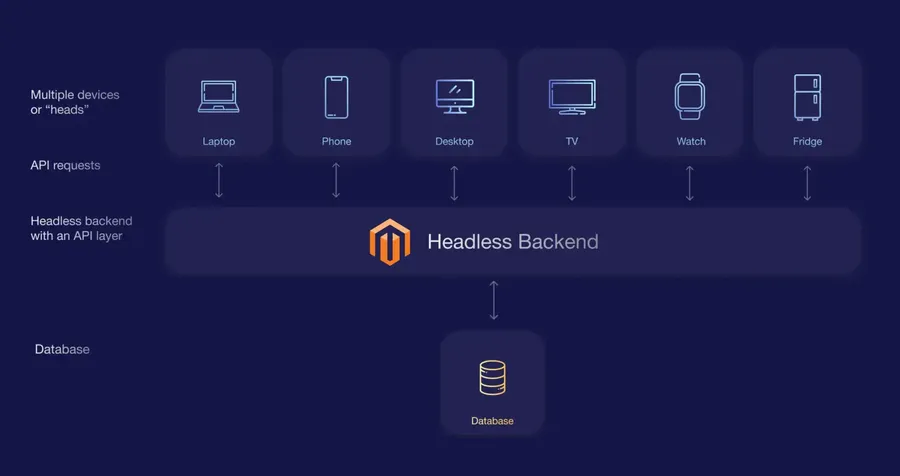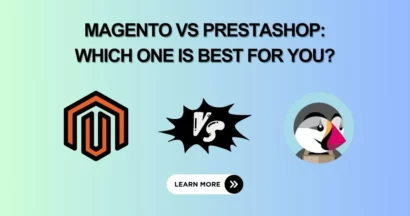Headless Magento is the future of eCommerce, offering unmatched flexibility and agility for businesses of all sizes. But what exactly is headless Magento? What are the differences between headless Magento vs. traditional Magento? What are the advantages and challenges of going headless with some real Magento 2 headless examples?
In this blog, we cover everything you need to know. Let’s get started!
What Is Headless Magento?
Headless Magento is an innovative approach to e-commerce development that decouples the front-end (visual interface) of a Magento store from its back-end (functionality and data processes). This means that the front-end, which includes the design, layout, navigation, and content that users see and interact with, is completely separate from the back-end, which manages the logic, data, and functionality, such as the database, CMS, and APIs. (Source: Headless commerce)

Headless Magento vs. Traditional Magento: Key Differences
Magento is a powerful eCommerce platform that can help you build a successful online store. But when it comes to choosing the right architecture for your store, you have two main options: headless Magento and traditional Magento.
Traditional Magento is the original, monolithic approach. This means that the front-end (what your customers see) and the back-end (what powers your store) are tightly coupled. This can make it difficult to change either side without affecting the other.
Headless Magento is a newer approach that separates the front-end and back-end. This gives you more flexibility to customize your store and create unique shopping experiences.

Here’s a table summarizing the key differences between Headless Magento vs. Traditional Magento:
| Feature | Headless Magento | Traditional Magento |
| Architecture | Decoupled (front-end and back-end are separate) | Monolithic (front-end and back-end are combined) |
| Flexibility | More flexible | Less flexible |
| Customization | Highly customizable | Less customizable |
| Performance | Faster loading times | Can be slower |
| Scalability | More scalable | Less scalable |
| Development resources | Requires more development resources | Requires fewer development resources |
| Cost | More expensive | Less expensive |
| Suitable for | Large businesses with complex needs | Small & medium businesses |
Key Benefits of Headless Commerce for Magento Stores
The headless platform is rapidly transforming the eCommerce landscape, offering Magento stores a plethora of advantages compared to the traditional monolithic approach. The separation of the front-end and back-end in Headless Magento offers several advantages:
- Enhanced flexibility and customization: Developers are not constrained by the limitations of the Magento platform when building the front-end. They can use any modern JavaScript framework or library to create a custom and unique shopping experience.
- Improved performance: Headless stores can be faster and more responsive than traditional Magento stores because the front-end and back-end are not tightly coupled.
- Better Magento omnichannel experiences: It helps to create consistent shopping experiences across different channels, such as web, mobile, and in-store.
- Easier to integrate with other applications: Headless Magento stores can be easily integrated with other applications, such as CRM systems, marketing automation platforms, and payment gateways, through APIs.
Headless Magento Drawbacks
While headless Magento offers exciting possibilities for developers and merchants, it’s important to weigh the potential drawbacks before diving in:
- Increased complexity: Requires building and maintaining separate front-end and back-end systems, adding technical overhead.
- Longer development time: Initial development can be slower due to the need for custom APIs and integrations.
- Higher cost: Initial investment can be higher due to additional development costs and the potential for increased technical expertise needed.
- Security concerns: Implementing proper security measures for APIs and managing multiple systems adds complexity.
- Limited out-of-the-box features: This may require building more functionalities from scratch compared to traditional Magento.
- Need for specialized skillset: Requires developers with expertise in headless architecture and API development.
- Less SEO-friendly: SEO optimization can be more challenging due to the separation of front-end and back-end concerns.
How Does Headless Magento Work?
In a Headless Magento setup, the front-end and back-end communicate with each other through APIs. The front-end makes requests to the back-end API to retrieve data, such as product information, prices, and customer orders. The back-end API then returns the requested data to the front-end.
Best Magento 2 Headless Case Studies
Rubik’s Cube

Rubik‘s is the company behind the famous Rubik’s Cube and other puzzle products. The company wanted to revamp its website with a modern, interactive, and mobile-friendly design, as well as features such as product personalization, social media integration, and gamification. The company chose to use Magento 2 headless with PWA Studio as the front-end framework, which allowed them to create a fast, responsive, and engaging user experience. The website is also integrated with Magento’s native features, such as checkout, catalog, and search, as well as third-party solutions, such as Klarna, Trustpilot, and Dotdigital
G-SP

G-SP is a Swedish fashion brand that offers sustainable and stylish clothing for women. The company wanted to create a unique and memorable online shopping experience and increase its conversion rates and customer loyalty. The company decided to use Magento 2 headless with Vue Storefront as the frontend framework, which enabled them to create a smooth, dynamic, and accessible user interface. The website also leveraged Magento’s powerful features, such as inventory management, order processing, and customer management, as well as third-party integrations, such as Klaviyo, Nosto, and LoyaltyLion
Zadig&Voltaire

Zadig & Voltaire is a French fashion brand that offers luxury and casual clothing and accessories for men and women. The company wanted to improve its website performance and user experience, as well as expand its global presence and omnichannel capabilities. The company opted for Magento 2 headless with Vue Storefront as the frontend framework, which allowed them to create a fast, responsive, and elegant user interface.
Is Headless Magento Right For You?
Headless Magento isn’t a one-size-fits-all solution. While it offers immense potential for flexibility and customization, it also requires a higher level of technical expertise and investment. Consider your business needs, budget, and technical resources before diving into the headless world.
If you’re a tech-savvy merchant yearning for a truly unique and scalable online store, Headless Magento might be your perfect match. With its decoupled architecture and API-driven approach, it empowers you to craft a shopping experience that transcends boundaries and delivers unparalleled value to your customers.
Don’t forget to check out Claue from ArrowTheme! Claue is a beautiful and responsive Magento theme that will make your store look great on all devices, including smartphones and tablets.
Read More: Which Is The Best Magento Web Development Agency?
Contact US | ThimPress:
Website: https://thimpress.com/
Fanpage: https://www.facebook.com/ThimPress
YouTube: https://www.youtube.com/c/ThimPressDesign
Twitter (X): https://twitter.com/thimpress


